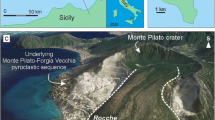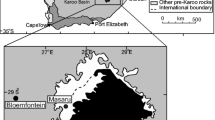Abstract
In 2014, the Pāhoa lava flow at Kīlauea, on the Island of Hawaiʻi (USA), entered a string of pre-existing meter-width ground cracks in the volcano’s East Rift Zone. The ground cracks transported lava below the surface in a direction discordant to the slope of the landscape. The cracks, which were 100s of meters long and 10s to 100s of meters deep, also widened by up to several meters as they filled, probably in part at the expense of adjacent cracks, which likely closed. Widening of the cracks caused shallow crustal blocks on the volcano’s flank to shift—this deformation was captured by a nearby GPS station and a borehole tiltmeter. The GPS station moved away from the cracks in response, while the tiltmeter showed tilting toward the cracks, consistent with opening. Noting that the lava-filled cracks act as top-fed dikes, we adapt existing theory for the thermo-rheological evolution of dikes to analyze transport of lava captured by ground cracks and propose mechanisms for the exit of the lava back to the surface. This study shows that ground cracks as narrow as 50 cm wide can facilitate the transport of advancing lava flows and can carry lava in directions that differ from those expected based on surface topography, invalidating flow path projections based on the assumption of subaerial flow.









Similar content being viewed by others
References
Brantley SR, Kauahikaua JP, Babb JL, Orr TR, Patrick MR, Poland MP, Trusdell FA, Oliveira D, Garcia MO, Camp VE, Grunder A (2019) Communication strategy of the U.S. Geological Survey Hawaiian Volcano Observatory during the lava-flow crisis of 2014–2015, Kīlauea Volcano, Hawai‘i. In: Poland MP, Garcia MO, Camp VE, Grunder A (eds) Field Volcanology: A Tribute to the Distinguished Career of Don Swanson. Geol Soc Am Bull Special Paper 588:351–373. https://doi.org/10.1130/2018.2538(16)
Bruce PM, Huppert HE (1989) Thermal control of basaltic fissure eruptions. Nature 342(6250):665–667. https://doi.org/10.1038/342665a0
Chanceaux L, Menand T (2014) Solidification effects on sill formation: an experimental approach. Earth Planet Sci Lett 403:79–88. https://doi.org/10.1016/j.epsl.2014.06.018
Delaney PT, Pollard DD (1982) Solidification of basaltic magma during flow in a dike. Am J Sci 282(6):856–885. https://doi.org/10.2475/ajs.282.6.856
Einarsson P, Brandsdóttir B (2021) Seismicity of the Northern Volcanic Zone of Iceland. Front Earth Sci 9. https://doi.org/10.3389/feart.2021.628967
Favalli M, Pareschi MT, Neri A, Isola I (2005) Forecasting lava flow paths by a stochastic approach. Geophys Res Lett 32(3):L03305. https://doi.org/10.1029/2004GL021718
Fialko YA, Rubin AM (1998) Thermodynamics of lateral dike propagation: implications for crustal accretion at slow spreading mid-ocean ridges. J Geophys Res Solid Earth 103(B2):2501–2514. https://doi.org/10.1029/97JB03105
Giordano D, Russell JK, Dingwell DB (2008) Viscosity of magmatic liquids: a model. Earth Plan Sci Lett 271(1–4):123–134. https://doi.org/10.1016/j.epsl.2008.03.038
Gudmundsson A (1987a) Tectonics of the Thingvellir fissure swarm SW Iceland. J Struct Geol 9(1):61–69. https://doi.org/10.1016/0191-8141(87)90044-7
Gudmundsson A (1987b) Geometry, formation and development of tectonic fractures on the Reykjanes Peninsula, southwest Iceland. Tectonophysics 139(3):295–308. https://doi.org/10.1016/0040-1951(87)90103-X
Hardee HC (1980) Solidification in Kilauea Iki lava lake. J Volcanol Geotherm Res 7(3–4):211–223. https://doi.org/10.1016/0377-0273(80)90030-X
Heliker C, Mattox TN (2003) The first two decades of the Pu‘u ‘Ō‘ō-Kūpaianaha eruption; chronology and selected bibliography. In: Heliker C, Swanson DA, Takahashi TJ (eds) The Puʻu ʻŌʻō-Kupaianaha Eruption of Kilauea Volcano, Hawaii—The First 20 Years. US Geol Surv Prof Pap 1676, pp 1–27. https://doi.org/10.3133/pp1676
Johanson IA, Miklius A, Ellis AP (2024) Tiltmeter data from Kīlauea’s East Rift Zone station JKA from August 1 to September 15, 2014. US Geol Surv data release. https://doi.org/10.5066/P902GG1M
Jones TJ, Houghton BF, Llewellin EW, Parcheta CE, Höltgen L (2018) Spatter matters—distinguishing primary (eruptive) and secondary (non-eruptive) spatter deposits. Sci Rep 8(1):9179. https://doi.org/10.1038/s41598-018-27065-1
Lister JR, Dellar PJ (1996) Solidification of pressure-driven flow in a finite rigid channel with application to volcanic eruptions. J Fluid Mech 323:267–283. https://doi.org/10.1017/S0022112096000912
Miklius A (2007) Hawaii GPS Network - JOKA-Jonika P.S., The GAGE facility operated by EarthScope Consortium, GPS/GNSS Observations Dataset. https://doi.org/10.7283/T58P5XR4
Neal CA, Brantley SR, Antolik L, Babb JL, Burgess M, Calles K, Cappos M, Chang JC, Conway S, Desmither L, Dotray P, Elias T, Fukunaga P, Fuke S, Johanson IA, Kamibayashi K, Kauahikaua J, Lee RL, Pekalib S, Miklius A, Million W, Moniz CJ, Nadeau PA, Okubo P, Parcheta C, Patrick MR, Shiro B, Swanson DA, Tollett W, Trusdell F, Younger EF, Zoeller MH, Montgomery-Brown EK, Anderson KR, Poland MP, Ball JL, Bard J, Coombs M, Dietterich HR, Kern C, Thelen WA, Cervelli PF, Orr T, Houghton BF, Gansecki C, Hazlett R, Lundgren P, Diefenbach AK, Lerner AH, Waite G, Kelly P, Clor L, Werner C, Mulliken K, Fisher G, Damby D (2019) The 2018 rift eruption and summit collapse of Kīlauea Volcano. Science 363(6425):367–374. https://doi.org/10.1126/science.aav7046
Okada Y (1992) Internal deformation due to shear and tensile faults in a half-space. Bull Seismol Soc Am 82(2):1018–1040. https://doi.org/10.1785/BSSA0820021018
Opheim JA, Gudmundsson A (1989) Formation and geometry of fractures, and related volcanism, of the Krafla fissure swarm, northeast Iceland. Geol Soc Am Bull 101(12):1608–1622. https://doi.org/10.1130/0016-7606(1989)101<1608:FAGOFA>2.3.CO;2
Orr TR, Zoeller MH, Llewellin EW, Patrick MR (2023) Eruption of stagnant lava from an inactive perched lava lake. J Volcanol Geotherm Res 442:107912. https://doi.org/10.1016/j.jvolgeores.2023.107912
Orr TR, Patrick MR (2019) GIS shapefiles for the June 27th lava flow at Kīlauea volcano, Hawaiʻi, June 2014–June 2016. US Geol Surv data release. https://doi.org/10.5066/P9LD5W2H
Orr TR, Poland MP, Patrick MR, Thelen WA, Sutton AJ, Elias, T, Thornber CR, Parcheta C, Wooten KM (2015) Kīlauea's 5–9 March 2011 Kamoamoa fissure eruption and its relation to 30+ years of activity from Pu‘u ‘Ō ‘ō. In: Carey R, Poland M, Cayol V, Weis D (eds) Hawaiian volcanism: from source to surface. Wiley, New Jersey. Am Geophys Union Geophys Monogr 208, pp 393–420. https://doi.org/10.1002/9781118872079.ch18
Orr TR, Ulrich GE, Heliker C, DeSmither LG, Hoffmann JP (2018) The Puʻu ʻŌʻō eruption of Kīlauea Volcano, Hawai‘i—Episode 21 through early episode 48, June 1984–April 1987. US Geol Surv Sci Invest Rep 2018–5109. https://doi.org/10.3133/sir20185109
Pansino S, Emadzadeh A, Taisne B (2019) Dike channelization and solidification: time scale controls on the geometry and placement of magma migration pathways. J Geophys Res Solid Earth 124(9):9580–9599. https://doi.org/10.1029/2019JB018191
Patrick M, Orr T, Fisher G, Trusdell F, Kauahikaua J (2017) Thermal mapping of a pāhoehoe lava flow, Kīlauea Volcano. J Volcanol Geotherm Res 332:71–87. https://doi.org/10.1016/j.jvolgeores.2016.12.007
Patrick MR, Kauahikaua JP, Orr T (2024) Stochastic lava flow forecasting code used during the 2014–2015 Pāhoa lava flow crisis, Kīlauea Volcano, Island of Hawaiʻi, in 2014–2015. US Geol Surv data release. https://doi.org/10.5066/P9H1DN3P
Poland M, Orr T, Kauahikaua J, Brantley S, Babb J, Patrick M, Neal C, Anderson K, Antolik L, Burgess M, Elias T, Fuke S, Fukunaga P, Johanson I, Kagimoto M, Kamibayashi K, Lee L, Miklius A, Million W, Moniz C, Okubo P, Sutton A, Takahashi T, Thelen W, Tollett W, Trusdell F (2016) The 2014–2015 Pāhoa lava flow crisis at Kīlauea Volcano, Hawai‘i: disaster avoided and lessons learned. GSA Today 26(2):4–10. https://doi.org/10.1130/GSATG262A.1
Sorey ML, Colvard EM (1994) Potential effects of the Hawaii Geothermal Project on ground-water resources on the Island of Hawaii. US Geol Surv Water Resour Invest Rep 94–4028. https://doi.org/10.3133/wri944028
Swanson DA, Duffield WA, Jackson DB, Peterson DW (1972) The complex filling of Alae Crater, Kilauea Volcano, Hawaiʻi. Bull Volcanol 36(1):105–126. https://doi.org/10.1007/BF02596984
Swanson DA, Duffield WA, Jackson DB, Peterson DW (1979) Chronological narrative of the 1969–1971 Mauna Ulu eruption of Kilauea Volcano, Hawaiʻi. US Geol Surv Prof Pap 1056. https://doi.org/10.3133/pp1056
USGS (2023) 1/3rd arc-second Digital Elevation Models (DEMs) - USGS National Map 3DEP Downloadable Data Collection. US Geol Surv. https://www.sciencebase.gov/catalog/item/4f70aa9fe4b058caae3f8de5
Wolfe EW, Neal CA, Banks NG, Duggan TJ (1988) Geologic observations and chronology of eruptive events. In: Wolfe EW (ed) The Puu Oo eruption of Kilauea Volcano, Hawaii; episodes 1 through 20, January 3, 1983, through June 8, 1984: US Geol Surv Prof Pap 1463, pp 1–97. https://doi.org/10.3133/pp146
Acknowledgements
We thank the staff and volunteers of the U.S. Geological Survey who assisted with collecting the myriad observations that helped us understand the evolution of the 2014 Pāhoa lava flow. David Okita of Volcano Helicopters provided expert piloting, which facilitated unparalleled access to eruptive activity at Kīlauea. D. Hyman, H. Murcia, and E. Rumpf provided insightful reviews that greatly improved the manuscript. EWL acknowledges support via Royal Society International Exchanges grant IE130961 and via NSFGEO-NERC grant NE/T009594/1.
Funding
Any use of trade, firm, or product names is for descriptive purposes only and does not imply endorsement by the U.S. Government.
Author information
Authors and Affiliations
Contributions
All authors contributed to the study conception and design, material preparation, data collection, and analysis. The first draft of the manuscript was written by TRO and all authors commented on previous versions of the manuscript. All authors read and approved the final manuscript.
Corresponding author
Ethics declarations
Competing interests
The authors declare no competing interests.
Additional information
Editorial responsibility: C. Solana
Rights and permissions
About this article
Cite this article
Orr, T.R., Llewellin, E.W., Anderson, K.R. et al. Pre-existing ground cracks as lava flow pathways at Kīlauea in 2014. Bull Volcanol 86, 41 (2024). https://doi.org/10.1007/s00445-024-01725-9
Received:
Accepted:
Published:
DOI: https://doi.org/10.1007/s00445-024-01725-9




